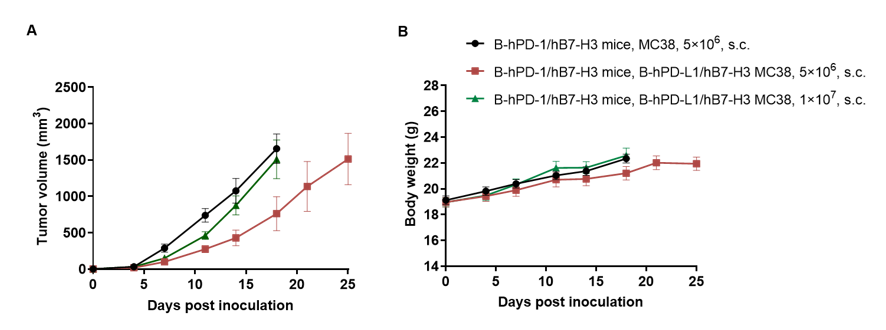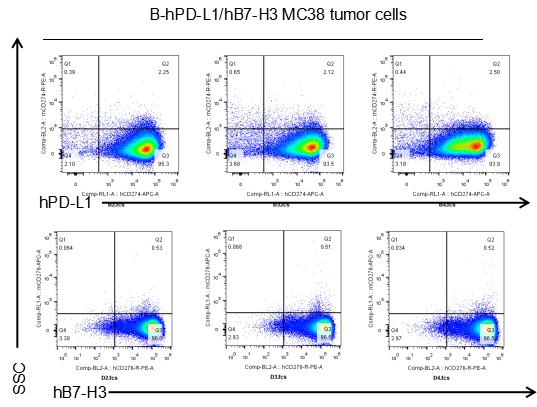B-hPD-L1/hB7-H3 MC38
|
Common name |
B-hPD-L1/hB7-H3 MC38 | Catalog number | 321842 |
| Aliases |
CD274;CD276 |
Disease | Colon carcinoma |
|
Organism |
Mouse |
Strain | C57BL/6 |
| Tissue types | Colon | Tissue | Colon |
The human PD-L1 and chimeric CDS including human B7-H3 were inserted into counterpart gene sites separately, so that the mouse Pd-l1 and B7-h3 were not expressed anymore, human PD-L1 and B7-H3 protein were highly expressed on the surface of B-hPD-L1/hB7-H3 MC38 cells.
Gene targeting strategy for B-hPD-L1/hB7-H3 MC38 cells. The exogenous promoter and full coding region sequences of human PD-L1 was inserted into the mouse Pd-l1 exon 3 in B-hPD-L1/hB7-H3 MC38 cells. The exogenous promoter and chimeric CDS consist of human B7-H3 extracellular plus mouse B7-h3 intracellular region sequences was inserted to replace part of murine exon 3 and all of exon 4 in B-hPD-L1/hB7-H3 MC38 cells.

PD-L1 and B7-H3 expression analysis in B-hPD-L1/hB7-H3 MC38 cells by flow cytometry. Single cell suspensions from B-hPD-L1/hB7-H3 MC38 cultures were stained with species-specific anti-PD-L1 antibody or anti-B7-H3 antibody. Human PD-L1 and B7-H3 were detected on the surface of B-hPD-L1/hB7-H3 MC38 cells. The 1-F06 clone of B-hPD-L1/hB7-H3 MC38 cells was used for in vivo experiments.

Subcutaneous homograft tumor growth of B-hPD-L1/hB7-H3 MC38 cells. B-hPD-L1/hB7-H3 MC38 cells (5x106 ,1x107) and wild-type MC38 cells (5x106) were subcutaneously implanted into B-hPD-1/hB7-H3 mice (female, 7-week-old, n=8). Tumor volume and body weight were measured twice a week. (A) Average tumor volume ± SEM. (B) Body weight (Mean± SEM). Volume was expressed in mm3 using the formula: V=0.5 × long diameter × short diameter2. As shown in panel A, B-hPD-L1/hB7-H3 MC38 cells were able to establish tumors in vivo, and clone 1-F06 can be used for efficacy studies.
Tips: B-hPD-L1/hB7-H3 MC38 cells can not establish tumors in wild-type C57BL/6 mice! Only can be used in B-hPD-1/hB7-H3 mice.
Protein expression analysis of tumor cells

B-hPD-L1/hB7-H3 MC38 cells were subcutaneously transplanted into B-hPD-1/hB7-H3 mice (n=8), tumor cells were harvested at the endpoint of the experiments and assessed for human PD-L1 and B7-H3 expression by flow cytometry. As shown, human PD-L1 and B7-H3 were highly expressed on the surface of tumor cells. Therefore, B-hPD-L1/hB7-H3 MC38 cells can be used for in vivo efficacy studies of novel PD-L1 and B7-H3 therapeutics.











